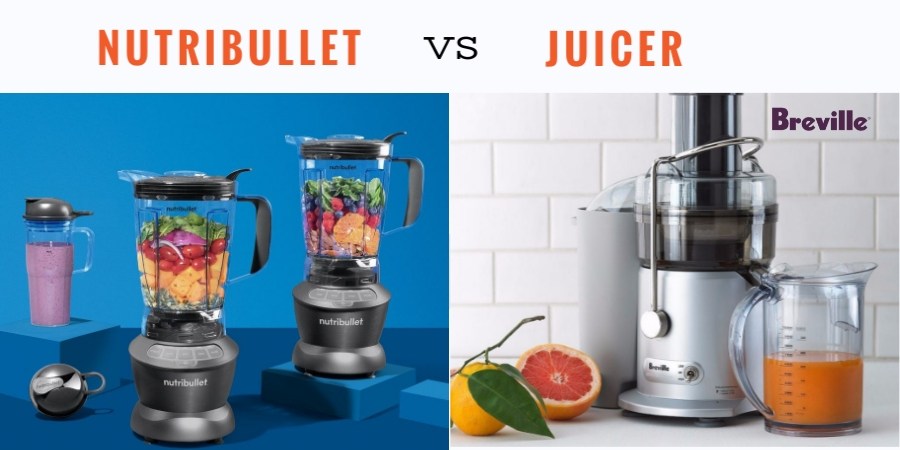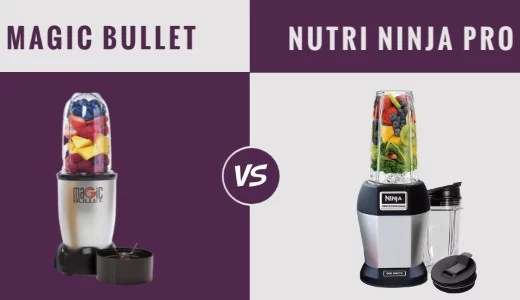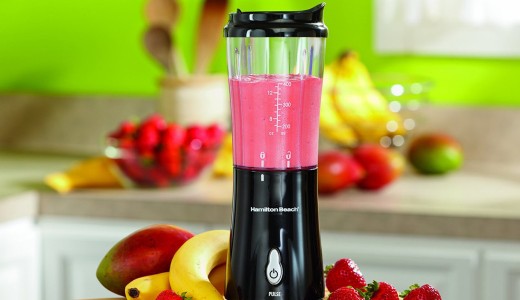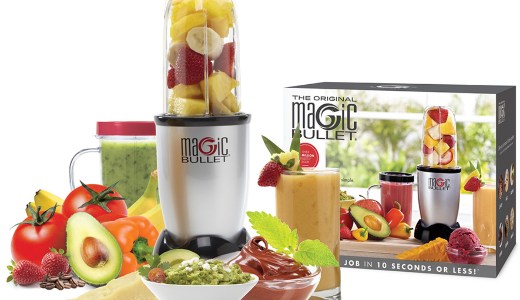Have you been looking for a new way to stay healthy on the go? You might consider making your own fresh juice or smoothies at home. To do that, you’ll need a blender or a juicer in your kitchen. But between NutriBullet vs. Juicer, which is better? This guide will help you learn the difference between these two health-centered appliances. This guide will even teach you which option is “healthier” for day-to-day use.
Staying healthy and living an on-the-go live style can be challenging. With both a career to maintain and a family to care for, it can feel like there isn’t a moment in the day to care for yourself.
Everyone has their tricks and tips for adding healthy habits into this kind of hectic schedule. But I have one that has served me well for a while now.
Simply put, you have to make being healthy, something you look forward to each day. In addition to my exercise regime, I found that the best way to accomplish this was to make eating healthy more appealing. I tried all kinds of “healthy” meal recipes, and almost all of them were flavorless and dry.
But then I learned about at-home juicing and smoothie-making. Both could not be easier and allow me to eat lots of nutritious food on the go. Since then, my NutriBullet blender and at-home Juicer have been a staple in my kitchen.
I believe you could benefit from either or both of these appliances, too. That’s why I’ve put together this helpful guide comparing the NutriBullet to a regular juicer machine.
Once you finish reading this guide, you’ll be prepared to decide which appliance will become the cornerstone of your new healthy diet.
Contents
What is a NutriBullet?
Let’s dive right into the action and discuss the NutriBullet. I love this modern take on the classic blender. I’ve found a million uses for it, all of which have done a number to improve my daily diet. Once you learn about the NutriBullet, you’ll want one for your kitchen, too.
When you first take a look at the NutriBullet, you might think it looks like a blender. That’s because the NutriBullet is, in essence, a modified blender. As a result, foods can be loaded into its upright chamber and blender until smooth with ease.
However, unlike other blenders, the NutriBullet’s jug is bullet-shaped. This allows the unit to more effectively blend down everything from fruits to nuts.
NutriBullets also come in two sizes – personal single-serve and standard full-size. The individual models can hold 600 ml of liquid. Meanwhile, the large models can hold up to 1.3 liters at a time.
As their title implies, the personal model is designed to make a single serving at a time. Using a special kind of cap, this kind of jug can also be taken on the go without needing to transfer cups.
The NutriBullet can utilize two types of blades. The first is a general-purpose blade that can chop up fruits and veggies without trouble. The second is a special use blade designed to grind up nuts and tough produce. Most models come with both, so you’ll have flexibility when using your NutriBullet.
What are NutriBullet blender’s health benefits?
I have been using a NutriBullet for a few years now. At that time, I have not seen it lab-tested. As such, I cannot say that it was designed to provide any certain health benefits. Despite that, I do know a few things about this blender’s performance.
First off, I know that the NutriBullet does a thorough job. Regardless of what produce I put in, it always comes out with a perfect texture.
That means that none of my produce is wasted, including the pulp. Fruit and veggie pulp can add an extra vitamin burst to your drink. So, it’s good that this blender leaves that all in.
Also, because the NutriBullet works so quickly, there is less time for vitamins and minerals to break down. Traditional blenders take a while to crush up their load.
This can cause friction to heat up and denature those key nutrients. You won’t have that problem with the NutriBullet, given its swift method of blending produce.
What is a Juice Extractor?
My juice extractor is also a mainstay in my kitchen. I use mine almost every day to make fresh-squeezed juice for my family. At this point, I rarely ever buy juice from the store. As such, I know that I am drinking healthier with my Juicer at my side.
Based on its name, you can probably juice what a juice extractor is. But if you still need a reminder, a juice extractor is a special kind of kitchen appliance designed to separate produce juice from the pulp.
This can be done using several different techniques. However, all juicers are prized for their ability to remove friction from the juicing equation.
Juicers come in several shapes and sizes. A juicer’s shape or size is usually based upon its primary juicing method. There are currently two popular juicing methods – centrifugal and masticating. However, most people refer to these simply as fast and slow juicing, respectively.
Fast juicing is the most common method and resembles blending in some ways. This method involves produce being inserted into a central juicing chamber.
Then, the produce is spun and chopped rapidly by a bladed disk. This causes juice to pour out of the produce. Meanwhile, all remaining pulp is collected and output separately.
Slow juicing, on the other hand, is less common. But those who use slow juicers always swear by their performance. These units also require manual insertion of produce.
From there, produce is fed into a narrow chamber where an auger crushes it. This process imitates human chewing. As a result, more juice comes out over time.
Also, juicers can be operated manually or electronically. Electronic models are usually considered more efficient.
Manual models, meanwhile, allow a user to customize better how much pressure is applied to their produce. This factor can be important, especially for folks looking to make juice at home for its nutritional content.
What are Juicer’s health benefits?
A juicer’s health benefits depend on its type. A slow juicer, for example, is better able to preserve nutrients locked into produce. This is because these juicers do not “tear” into produce.
Instead, they squeeze them until juice pours out. This gentler method also introduces almost no friction that would cause those nutrients to denature.
Meanwhile, a fast juicer has fewer health benefits. These units can tend to “chop” up nutrients due to their rapid operation speed.
However, this unit’s speed does make it more convenient to use. As such, an on-the-go user will be more able to use these appliances to replace other less healthy drinks.
Along the same lines, any homemade juice is likely to be a healthier option compared to store-bought juice. Those juices contain preservatives and lots of processed sugar.
Folks who want to cut those out of their diet can count on their Juicer to provide. At-home juicing also saves money in this way, which can be seen as its benefit.
What is the difference between the NutriBullet and a Juicer?
This is the question I hear the most that I answered it a few times for my friends at the gym already. But you may not have experience with either appliance yet.
So, it is vital to establish a difference right now. With that information, you’ll be able to decide which appliance is right for your home.
Let’s start by talking about the general operation. At face value, a NutriBullet and a fast juicer may appear similar. Their method of rapidly tearing up produce even sounds the same.
But in practice, a NutriBullet crushes up the whole fruit or veggie. Meanwhile, a juicer separates the pulp from the juice.
As a result, a fast juicer and a NutriBullet output very different products. A juicer’s output is usually thinner and often partially clear in color.
A NutriBullet, on the other hand, often outputs a thicker product due to its inclusion of pulp in the mix. This thicker product may be healthier, as well, but to its inclusion of the pulp.
Don’t forget about slow juicers, though. Their operation does not resemble a NutriBullet at all. They crush up produce slowly while still separating pulp.
This results in their juice being even thinner. But, as a tradeoff for lost texture, these juices tend to be more nutrient-rich.
As for prices, the NutriBullet tends to be the cheaper option. Their basic model costs around $60. This is compared to a slow juicer, which can cost $100 or more for a basic unit. Some fast juicers are affordably-priced, though.
Some popular brands even price their fast juicers as low as $60 (see the full review of the Hamilton Beach 67601A).
Is a NutriBullet the same as a juicer?
No, a NutriBullet is not the same as a juicer. A NutriBullet is more like a regular blender than any juicer. That’s because a NutriBullet grinds up all kinds of produce in a central jug.
That being said, a NutriBullet is still unlike a regular juicer. That’s because their “jug” is bullet-shaped. This makes the jug easy to use as a personal drink container after blending is complete.
A juicer is also different than a NutriBullet when it comes to a pulp. To be specific, a juicer always filters out the pulp from a juice mixture.
A NutriBullet, on the other hand, mixes it right in. This can make a difference in their respective final products. NutriBullet mixes have a thicker texture, which juicer blends tend to be richer in flavor.
Can a NutriBullet be used as a juicer?
No, a NutriBullet is not intended to be used as a juicer. To that end, a NutriBullet is not designed to separate the juice from the pulp in any way.
Instead, these units blend all produce parts to make a smoothie-like mixture. These mixtures can be made up of everything from fruits and veggies to leafy greens and nuts.
That being said, you could mix different juices in a NutriBullet. Even a quick pulse on a NutriBullet would mix most types of juice.
A NutriBullet can introduce heat into a juice mix, though. So, using a NutriBullet for this purpose must be done carefully.
Is it better to juice or blend?
This is a classic question. Many folks will claim to have an easy answer. But in my experience, the solution is more personalized.
Some people will find blending to be more comfortable because it involves less prep. Others may prefer juicing because it is better able to preserve flavor. Either way, the critical focus should always be on forming healthy eating habits.
That being said, I know that I blend my produce more often. That’s because I prefer the thicker texture a blended drink provides.
However, I still juice a couple of times a week. I mostly serve my homemade juice to my family. But I also sometimes mix it into my blender mixes.
So, in reality, you need not choose one or the other. Juicing and blending are equally valid ways of replacing unhealthy drinks in your diet. You can even use both in tandem as I do.
If you’re just starting, blending may be easier due to its minimized prep. But once you’re ready to take the next step, a juicer will up your health game.
Which is healthier – juicing or blending?
As I’ve said, both juicing and blending can be part of a healthy diet. As such, it isn’t so important that one be “healthier” than the other. So long as you are still getting your daily nutrients through your blend or mix, you should be on a positive track.
That being said, juicing and blending may have slightly different potential health benefits. For example, homemade juices tend to be denser in nutrients.
However, homemade blends tend to be thicker, which promotes positive digestion. Depending on your day-to-day health needs, you may choose either.
Which Is Better for Losing Weight?
Generally speaking, both juicing and blending hold the potential for helping you lose weight. However, no one juice or blend alone can accomplish that task. Instead, your juice or blend should be part of a balanced diet that includes exercise.
Ideally, a homemade blend or juice can replace other liquids in your diet. For example, I use my homemade juices to cut soda out of my diet entirely.
I also use my homemade blends to cut expensive smoothies out of my diet (and budget). As a result, I’ve effectively cut out these sources of sugar. I feel that this has helped me lose weight.
How to Make a Smoothie with a NutriBullet
Making a smoothie or any kind of blend with a NutriBullet can be easy. All you need to do is understand the basics, as well as which items to avoid blending. Pretty soon, you’ll be able to experiment and make new blends to fit your precise tastes.
The Basics
After procuring your NutriBullet, your first step should be to take stock of your produce options. This can include any kind of fruit or veggie, all of which should be chopped up.
Also, feel free to grab some leafy green vegetables and any milks you like. Then, have a couple of cups of ice on hand.
Once you have your ingredients in front of you, you can begin to add them to the Bullet. First, place in your ice. In total, your ice should not fill more than 25% of the jug.
Then, add in your most dense produce. This may include apples, beets, broccoli, and others. This placement will ensure that these fruits and veggies are properly broken down.
From there, you can begin to layer in your leafy greens and your softer produce. Kale, spinach, oranges, and bananas can all go into the Bullet at this point.
Those can be topped with any special add-ins you may use, such as chia seeds or protein powder. Finally, add in any liquids last. This will prevent any splashing or run over.
Before attaching the Bullet’s blade, be sure that you haven’t overfilled your jug. You’ll notice that there is a “Max Fill” line printed on the jug. Do not exceed this line, or you will risk leaking from your jug while it is blending.
After double-checking your jug’s volume, you are ready to place the blade cap on. Then, place the sealed jug onto the base and twist clockwise until it clicks into place.
As you do this, the NutriBullet will activate and begin to blend. Be sure to keep an eye on your NutriBullet as this occurs.
Depending on your chosen produce, this process can take anywhere from 30-60 seconds. Once your blend reaches the desired texture, you can stop the Bullet by twisting it counter-clockwise.
Finally, you are ready to enjoy your blend or smoothie. To do this, invert the Bullet and remove the blade cap. Then, carefully pour your mixture into your desire cup or bottle.
However, if you are on-the-go, you can also use this Bullet as a bottle on its own. Simply attach the flip-top lid that came with the unit, and you are good to go.
Foods and Drinks to Avoid
Once you get the hang of it, you may feel like you can blend anything in your NutriBullet. But the truth is, not all foods and drinks are appropriate for use in a NutriBullet.
For example, you should never put any actively hot drinks into your NutriBullet. As such, you should be sure that any tea or coffee added to your blends is adequately cooled in advance.
Also, you should never add carbonated drinks to your blends. This is because the carbonation inside these drinks will be released during the blending process.
This can cause the cap to become pressurized, which may lead to damage or injury if it fails. So, even though you may love seltzer and sparkling water, it should be left out of your NutriBullet.
Blends for Health and Fitness
I’ve been making new blends on my NutriBullet for a few years now. I’ve found a few recipes along the way that have really treated by pallet well. You should try some out, too, and see if they help you add more nutrients to your daily diet.
Green Fruits Blend
I‘ve always been partial to fruits over veggies. So, I made this juice blend that is heavy on fruity flavors. I don’t even taste the spinach in this drink, but I do see it in the final product’s green hue.
- 1 cup chunk pineapple
- 2 cups spinach
- ¼ cup grapes (green or red)
- 1 ½ cup orange juice (ideally homemade)
- ½ banana
- Ice
Spiced Strawberry Citrus Blend
This a simple blend I came up with to get my kids interested in trying by smoothies. The fruits in this mixture are not too strong, so even a younger pallet can appreciate them. The ginger is also reasonably subtle, allowing it to be just a bit livelier than a plain old smoothie.
- One banana
- 2 cups frozen strawberries
- ¼ cup orange juice (ideally homemade)
- Fresh ginger root (add to taste)
Green Machine Blend
Even adults need to eat their greens. This blend makes that easy to do. If you’re not a fan of apples, feel free to switch it out for a comparable amount of another fruit. You’ll be surprised at what kind of flavorful creations you can come up with on your own!
- Two medium apples (organic is best)
- Three stalks celery
- Two kale leaves
Your Takeaway
So, now you understand the difference between a typical juicer and NutriBullet blender. Though they are different in their purpose, they can both play a crucial role in helping you form healthier eating and drinking habits in the future.
Suffice to say, and I believe that you should invest in a juicer or a NutriBullet. I don’t see one as being inherently better than the other. What matters most is which option is affordable to you and which option fits in best with your current lifestyle.
Don’t wait, though! Be sure to commit to buying a blender from NutriBullet or a standard juicer soon so that you, too, can reap the health rewards that come with drinking natural nutrients every day.





